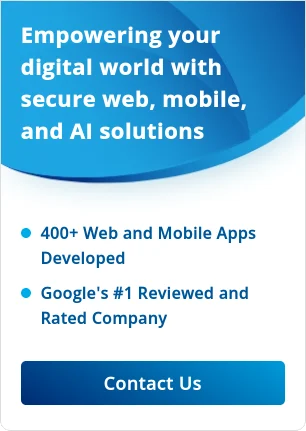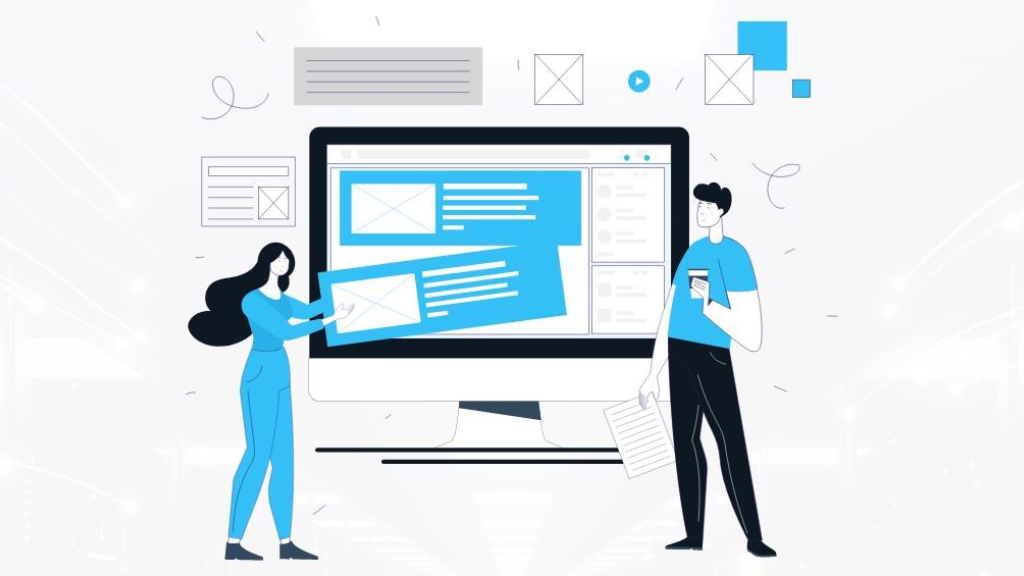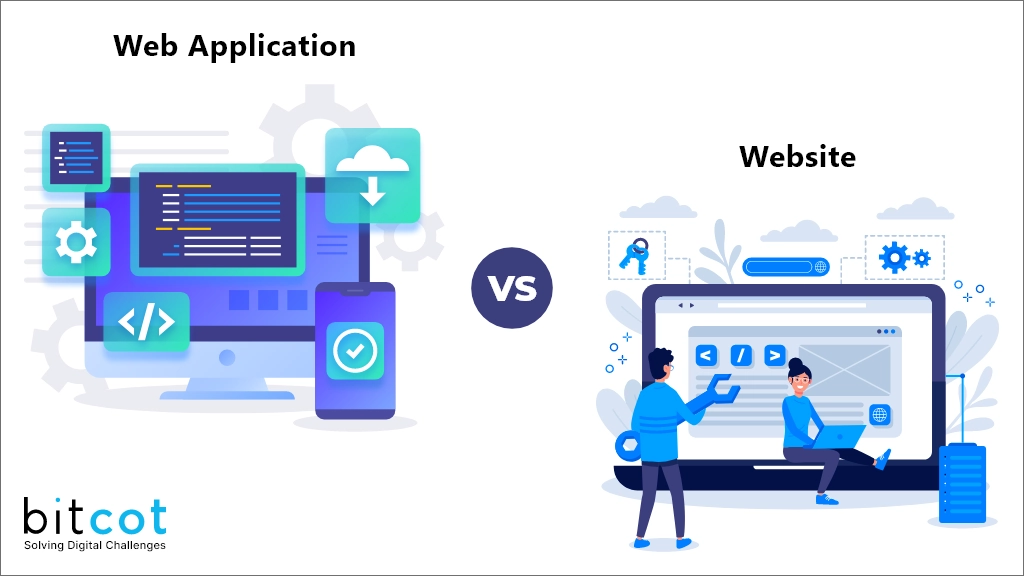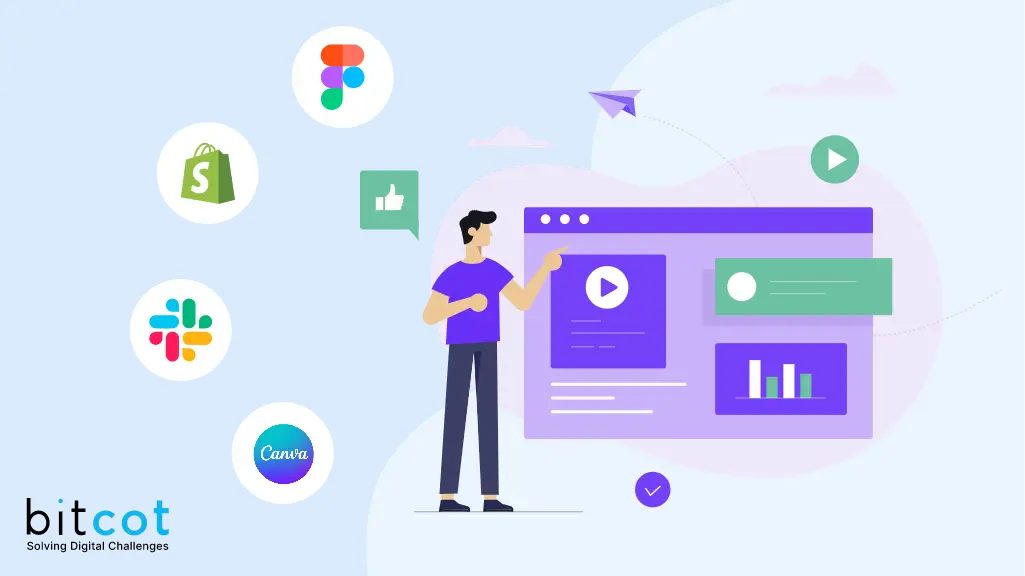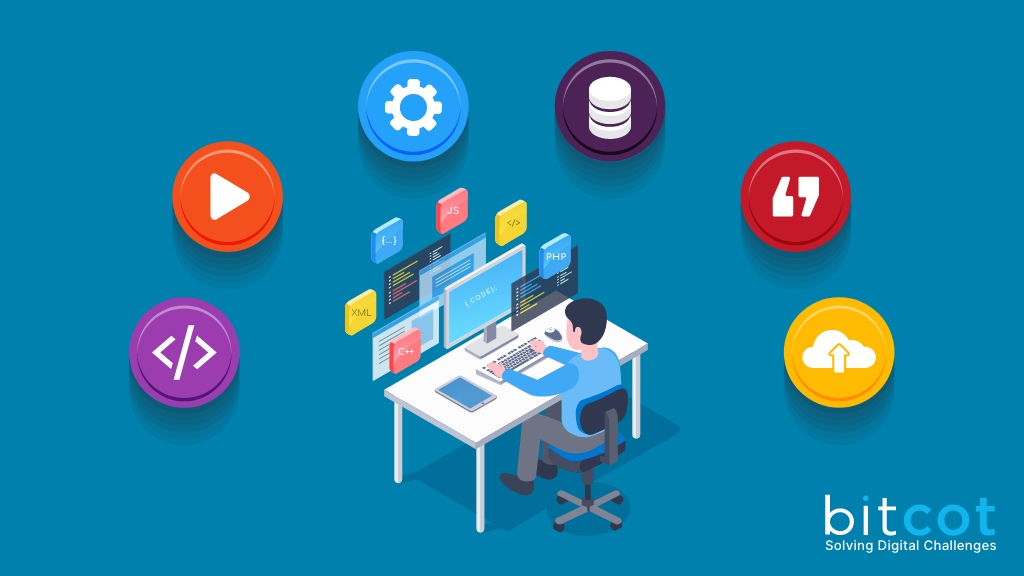
In today’s digital age, businesses increasingly rely on web applications to drive growth, improve efficiency, and deliver exceptional user experiences. As a business owner or CEO, it is crucial to understand the concept of web applications and how they can benefit your organization. In this topic, we will provide a comprehensive introduction to web applications, highlighting their importance as revenue generator and a key differentiator for businesses.
A web application can be defined as a software application accessed through a web browser, allowing users to interact with it over the internet. Unlike traditional websites that primarily provide static information, web applications are dynamic, interactive, and often tailored to specific user needs. They offer a wide range of functionality, from e-commerce platforms and customer relationship management systems to collaboration tools and online banking portals.
So, why should business owners and CEOs pay attention to web applications? The answer lies in their potential to increase revenue and transform business operations. Web applications enable companies to reach a broader audience by providing convenient access from any device with an internet connection. This accessibility opens up new opportunities for customer acquisition and engagement, leading to increased sales and revenue.
Furthermore, web applications can be a powerful differentiator in today’s competitive market. Businesses can stand out and build strong customer loyalty by offering unique features, seamless user experiences, and personalized interactions. A well-designed and user-friendly web application has the potential to become a game-changer for businesses, attracting new customers and retaining existing ones.
In this post, we will explore the various aspects of web application development, equipping you with the knowledge and tools to leverage this technology effectively. Whether you plan to build a web application from scratch or enhance an existing one, understanding the principles and best practices of web application development will be invaluable.
Throughout the following topics, we will dive into the differences between web applications and websites, explore the different types of web applications, examine how web applications work within a browser, analyze successful case studies, delve into the development process, and discuss the frameworks and tools involved. We will also touch upon the low-code development and reusability concept, highlighting how they can optimize the development process.
By the end of this post, you will have a comprehensive understanding of web application development and the steps involved in building and launching successful web applications. You will be equipped with the knowledge to make informed decisions, collaborate effectively with development teams, and ultimately harness the power of web applications to drive your business forward.
Understanding Web Applications
What is a Web Application?
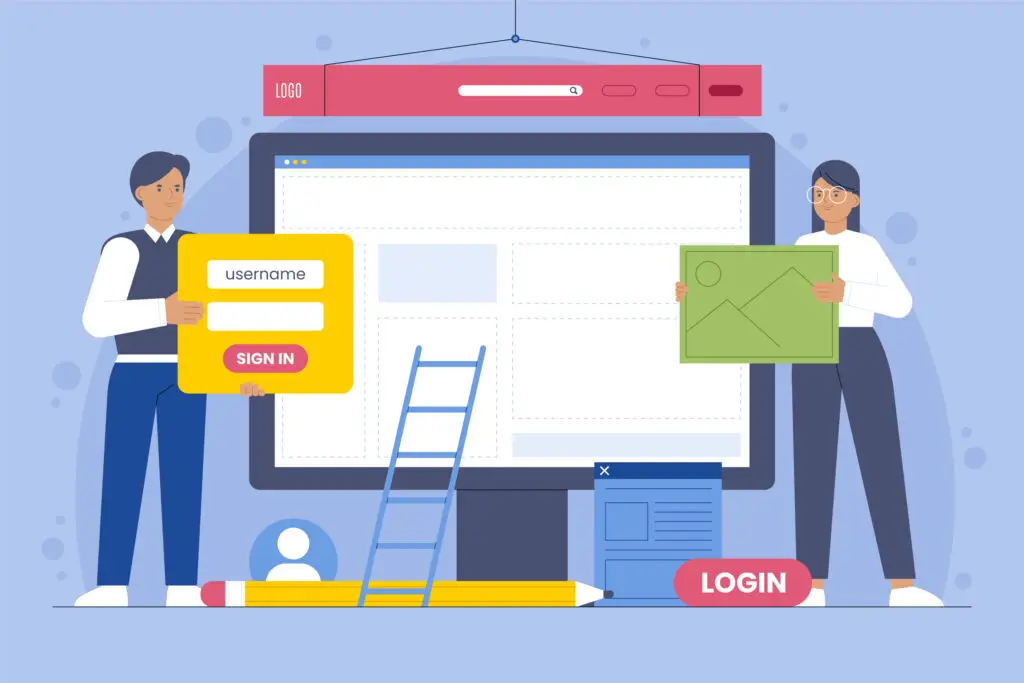
Web applications have revolutionized the way businesses operate in the digital landscape. In this topic, we will delve into the fundamentals of web applications, providing you with a solid understanding of their purpose, functionality, and advantages.
A web application is a software application that runs on a web server and is accessed through a web browser. Unlike traditional websites that primarily provide static information, web applications are dynamic and interactive, allowing users to perform specific tasks, input data, and receive customized outputs. They leverage the capabilities of modern web technologies, such as HTML, CSS, and JavaScript, to deliver rich user experiences and real-time data processing.
Difference Between Web Application and Website
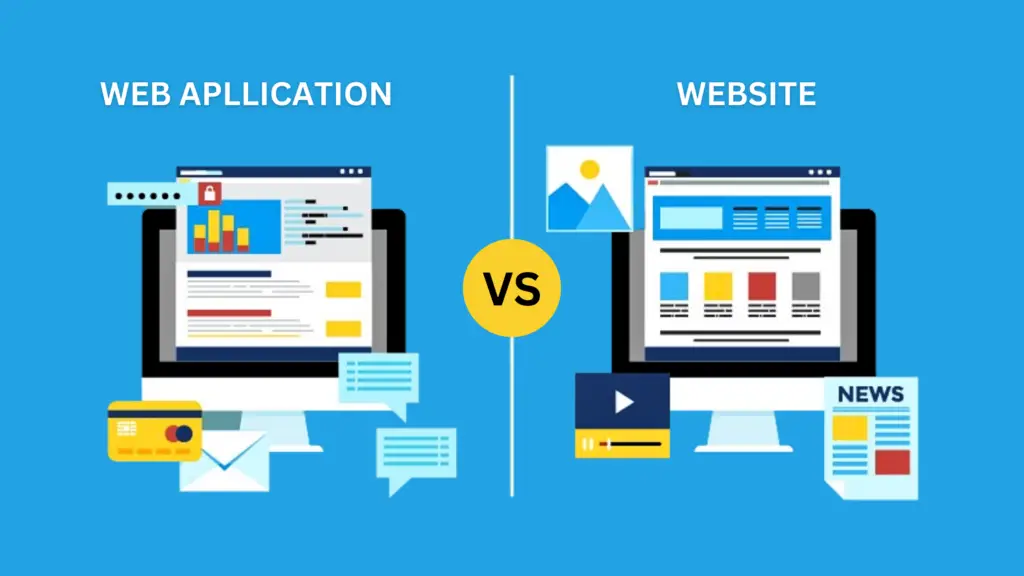
A website and a web application are two different terms often used interchangeably, but they are not the same. A website is a collection of web pages hosted on a single domain name intended to provide visitors with information. Websites can be static or dynamic, but they are designed primarily to deliver content. Websites are typically developed using HTML, CSS, and JavaScript.
So, what sets web applications apart from websites? While websites primarily focus on providing information, web applications go beyond that by enabling users to complete tasks, engage in transactions, and interact with complex systems.
For example, an e-commerce website may allow users to browse products and make purchases. Still, a web application would provide additional functionalities like order tracking, personalized recommendations, and customer support.
Benefits of Web Applications for Businesses
The benefits of web applications for businesses are numerous. First and foremost, web applications offer unparalleled accessibility. Users can access web applications with an internet connection from any device, be it a desktop computer, laptop, tablet, or smartphone. This flexibility allows businesses to reach a wider audience and cater to the growing number of mobile users.
Moreover, web applications offer real-time data processing and synchronization. Changes made by one user are instantly reflected across all devices and sessions, ensuring data consistency and collaboration. This feature mainly benefits businesses that rely on shared data, such as project management tools or collaborative document editing platforms.
Additionally, web applications provide the opportunity for personalization and customization. Businesses can deliver personalized content, recommendations, and user experiences by gathering user data and preferences. This level of personalization enhances user engagement and increases the likelihood of conversions and customer loyalty.
Web applications have become a critical component of modern business strategies. They offer enhanced interactivity, real-time data processing, accessibility, and personalized user experiences. Understanding the distinct advantages of web applications is essential for business owners and CEOs looking to leverage this technology to increase revenue and differentiate their organizations.
Types of Web Applications
Web applications can be broadly categorized into three main types: client-side web applications, server-side web applications, and hybrid web applications. Each type has its characteristics, advantages, and considerations.
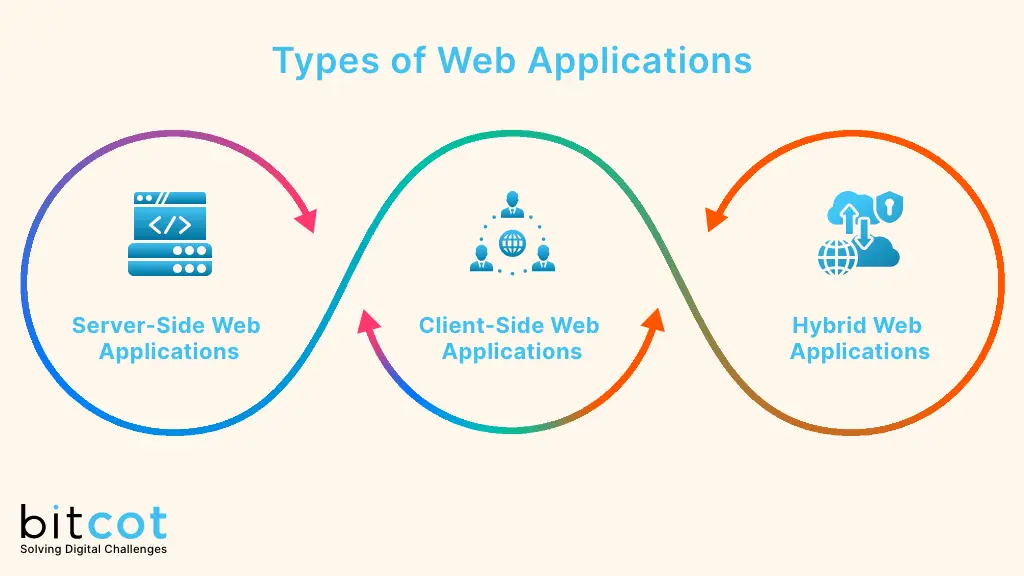
- Client-side Web Applications: As the name suggests, client-side web applications primarily rely on the user’s web browser for processing and functionality. They are built using web technologies such as HTML, CSS, and JavaScript. When a user interacts with a client-side web application, all the processing and rendering occur on the client side (the user’s browser). These applications are known for their responsiveness and interactivity.
- Server-side Web Applications: Server-side web applications handle the processing on the server and deliver the results to the user’s browser. They are typically built using server-side programming languages like Python, Ruby, or PHP. Server-side web applications are capable of handling complex business logic and database operations. They offer scalability and maintainability as the core processing occurs on the server, reducing the load on the client side.
- Hybrid Web Applications: Hybrid web applications combine elements of both client-side and server-side processing. They aim to leverage the strengths of both approaches. Hybrid applications use client-side technologies to render the user interface and enhance interactivity, while server-side technologies handle business logic and data processing. This hybrid approach provides flexibility and allows for optimal performance and user experiences.
- Progressive Web Applications (PWAs): Within the realm of hybrid web applications, one notable development is the concept of Progressive Web Applications (PWAs). PWAs are web applications that leverage modern browser capabilities to provide a native-like experience to users. They utilize service workers, a technology that allows offline functionality, push notifications, and caching of web assets. PWAs are designed to be responsive, reliable, and engaging, regardless of the user’s network connectivity or device capabilities. They blur the line between web and native applications, offering a seamless user experience.
Modern browsers are evolving to support PWAs and provide tailored features. Browsers like Google Chrome, Mozilla Firefox, and Microsoft Edge have made significant advancements in supporting PWAs, such as installing them as standalone applications, integrating them with the operating system, and providing offline capabilities. These browser enhancements have propelled the adoption of PWAs and opened up new opportunities for businesses to deliver powerful and engaging web applications.
By understanding the different types of web applications and the emergence of PWAs, you can make informed decisions about the most suitable approach for your business needs. In the next topic, we will delve into the inner workings of web applications within a browser, exploring the client-server model, the request-response cycle, and the components involved. This knowledge will further deepen your understanding of how web applications function and interact with users.
How Web Applications Work in a Browser
Several processes occur behind the scenes when you interact with a web application, whether it’s a simple form submission or a complex data-driven task. These processes involve the collaboration between the client (your web browser) and the server hosting the web application. Let’s explore the key components and steps involved in the functioning of web applications.
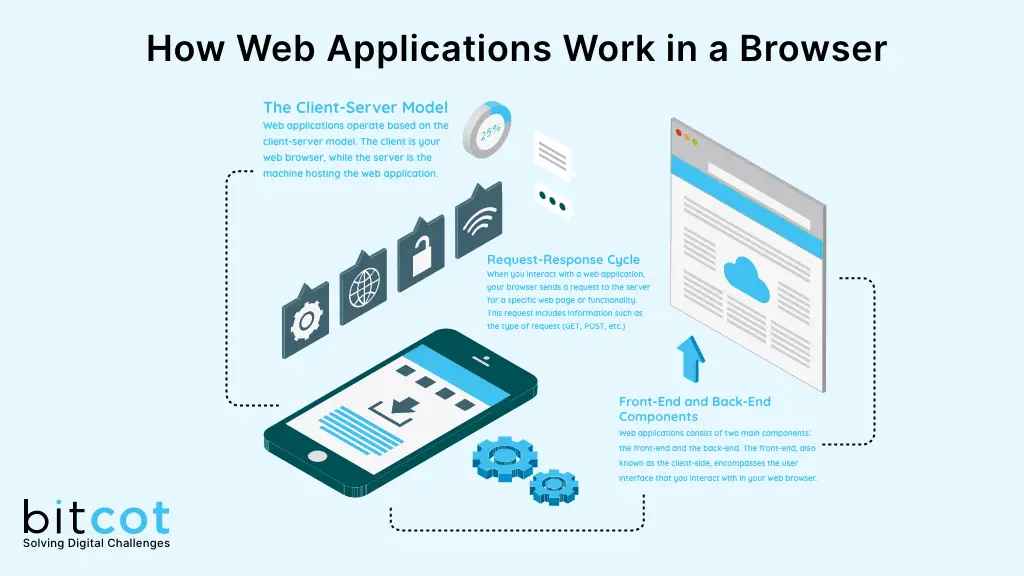
- The Client-Server Model: Web applications operate based on the client-server model. The client is your web browser, while the server is the machine hosting the web application. The client sends requests to the server, and the server processes these requests, performs the necessary operations, and sends back the corresponding responses. This interaction is at the core of how web applications function.
- The Request-Response Cycle: When you interact with a web application, your browser sends a request to the server for a specific web page or functionality. This request includes information such as the type of request (GET, POST, etc.), any data being sent, and other necessary details. The server processes the request, performs the required actions, retrieves data from databases or external APIs if needed, and prepares a response.
- Front-End and Back-End Components: Web applications consist of two main components: the front-end and the back-end. The front end, also known as the client side, encompasses the user interface that you interact with in your web browser. It includes elements such as HTML markup for structure, CSS styles for presentation, and JavaScript for interactivity. On the other hand, the back end, or the server side, handles the web application’s processing, logic, and data management. It may involve server-side programming languages like Python, Ruby, or PHP, as well as databases for storing and retrieving data. The back end interacts with the front end, processing user inputs, and generating appropriate responses.
- Rendering and Displaying: Once the server sends the response back to the client (your browser), the browser interprets the received data and renders it as a web page. The browser takes the HTML markup and applies the CSS styles to present the content visually appealingly. If the web application includes dynamic elements, JavaScript manipulates the HTML and updates the user interface accordingly.
- Event-Driven Interactions: Web applications are built to respond to user interactions, such as clicking buttons, submitting forms, or scrolling. These interactions trigger events that are handled by JavaScript code running in the browser. The JavaScript code can perform various actions, such as making additional requests to the server, updating the page content dynamically, or validating user inputs.
By understanding the client-server model, the request-response cycle, and the front-end and back-end components, you gain insight into how web applications function within a browser. This understanding helps you make informed decisions when designing user interfaces, optimizing performance, and ensuring a smooth user experience.
As modern browsers evolve, they provide enhanced support for web applications, including capabilities for offline usage, push notifications, and advanced interactivity. Keeping up with the latest browser advancements can further empower you to leverage these features and create engaging web applications.
Successful Web Applications Case Studies
In this topic, we will explore real-world case studies of successful web applications that have significantly impacted their respective industries. By examining these examples, we can gain valuable insights into the strategies, techniques, and lessons learned that contribute to their success.
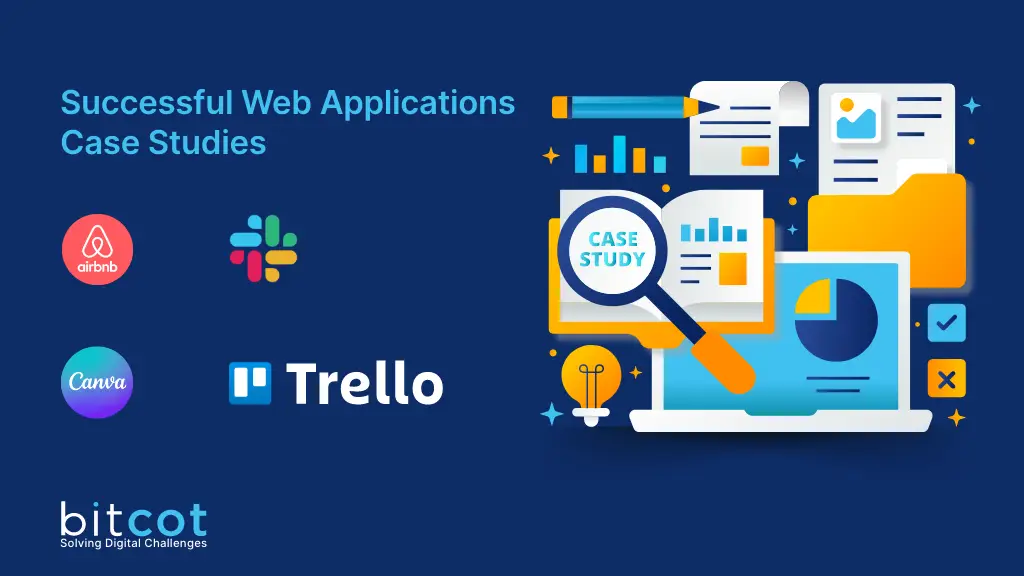
- Airbnb: Airbnb revolutionized the hospitality industry by providing a platform for homeowners to rent out their properties. Through an iterative approach, Airbnb continuously improved its web application by incorporating user feedback and enhancing the user experience. Features such as user reviews, secure payments, and a seamless search and booking interface were crucial in establishing market fit and disrupting the traditional hotel industry.
- Slack: Slack, a collaboration and communication platform, started as an internal tool and evolved into a widely adopted web application. Through iterations and user-centric design, Slack refined its features and created an intuitive interface that appealed to businesses of all sizes. By actively listening to user feedback and implementing requested features, Slack established itself as a dominant player in the team communication space.
- Trello: Trello, a web-based project management tool, gained popularity due to its simplicity and flexibility. By taking an iterative approach to development, Trello gradually added features based on user feedback, focusing on enhancing collaboration and visualizing workflows. The continuous iteration process resulted in a web application that resonated with individuals and teams across various industries.
- Canva: Canva disrupted the graphic design industry by offering an accessible online design tool. Canva adopted an iterative development approach, constantly refining its features and incorporating user suggestions. Their focus on making graphic design accessible to everyone, regardless of technical expertise, allowed Canva to establish market fit and attract millions of users worldwide.
The success stories of these web applications highlight the importance of an iterative approach to development. By releasing an MVP and gathering user feedback, developers can learn valuable insights about user preferences, pain points, and desired features. This feedback loop enables continuous improvement, ensuring that the web application aligns with market needs.
Iterative development also helps businesses establish market fit by refining their value proposition, optimizing user experiences, and differentiating themselves from competitors. Through constant iteration and adaptation, web applications can find their niche, attract a loyal user base, and achieve sustainable growth.
In the next topic, we will explore the process of building a web application, providing a step-by-step guide that takes you from the initial idea to a successful launch. Understanding this process will equip you with the knowledge and tools to effectively plan, execute, and iterate on your own web application projects.
The Web Application Development Process
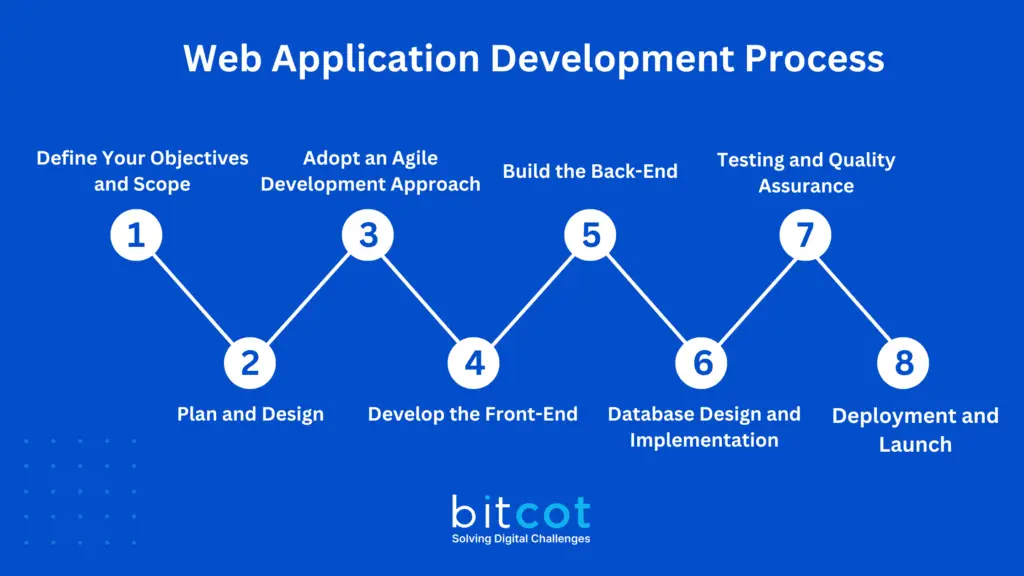
Developing a web application requires careful planning, execution, and an iterative mindset. In this topic, we will walk you through a step-by-step guide on how to build a web application. We will also explore the importance of adopting and customizing an agile process to suit your specific needs while maintaining speed and agility.
- Define Your Objectives and Scope: Start by clearly defining the objectives and scope of your web application. Understand your target audience, identify the core functionalities, and outline the desired features. Establishing a clear vision will guide the entire development process.
- Plan and Design: Create a comprehensive plan and design for your web application. This involves wireframing the user interface, creating mockups, and mapping out the user flow. Take the time to consider usability, accessibility, and the overall user experience.
- Adopt an Agile Development Approach: Agile development methodologies, such as Scrum or Kanban, provide a framework for iterative and flexible development. Embrace the Agile principles of frequent collaboration, adaptive planning, and continuous improvement. Break down the project into smaller tasks, prioritize them, and work on them in short iterations or sprints.
- Develop the Front-End: Start by developing the front-end of your web application. Use HTML, CSS, and JavaScript to build the user interface and implement the desired functionality. Ensure that the front-end design is responsive and optimized for different devices and screen sizes.
- Build the Back-End: Simultaneously, work on building the back-end of your web application. Select an appropriate server-side programming language, such as Python, Ruby, or PHP, and set up the necessary infrastructure. Implement the business logic, data management, and integrations with external services or APIs.
- Database Design and Implementation: Design and set up a database to store and manage your web application’s data. Choose a suitable database management system (DBMS) and define the database schema. Implement the necessary queries and ensure data security and integrity.
- Testing and Quality Assurance: Thoroughly test your web application to identify and fix any bugs or issues. Perform unit, integration, and user acceptance testing to ensure functionality and quality. Consider automated testing tools to streamline the testing process and improve efficiency.
- Deployment and Launch: Prepare your web application for deployment by setting up hosting infrastructure, configuring servers, and optimizing performance. Consider utilizing cloud platforms or web hosting services for scalability and reliability. Once ready, launch your web application and make it accessible to users.
- Customizing the Process to Suit Your Needs: While following a structured development process is essential, it’s crucial to customize it to suit your specific requirements. Every project is unique, and you may need to adapt certain aspects to align with your team’s capabilities, business goals, or project constraints. Customize the process while keeping in mind the need for speed and agility. Avoid unnecessary bureaucracy or rigid procedures that could hinder progress.Embrace the iterative nature of web application development. Continuously gather user feedback, conduct usability testing, and make iterative improvements based on the insights gained. This iterative process allows you to respond to user needs and market dynamics effectively.Remember that collaboration and communication within your development team are essential. Regularly meet to discuss progress, address challenges, and adjust priorities as needed. Emphasize transparency, open dialogue, and a culture of learning and improvement.You can balance adaptability and efficiency by combining an agile mindset with customization.
- Select the Ideal Web App Development Company: When selecting the ideal web app development company with UI/UX designers, web application developers, and market specialists, it’s important to consider their expertise in each area. The UI/UX designers should have a strong portfolio of creating visually appealing and user-friendly interfaces. Web application developers should have experience in building scalable and secure applications using the latest technologies and frameworks. Market specialists should have a deep understanding of your target audience and be able to provide insights into market trends and user behavior.
This approach ensures that your web application development process remains dynamic, responsive, and tailored to your project requirements. In the following topic, we will explore different web application development frameworks that can expedite the development process and provide additional functionalities for your web applications.
Web Application Development Frameworks
When building a web application, leveraging the right development frameworks can significantly expedite the process and provide a solid foundation for your project. In this topic, we will explore several popular frameworks, each offering unique advantages and capabilities.
[ Also Read: Top 5 Front End Frameworks for Web Development in 2023 ]
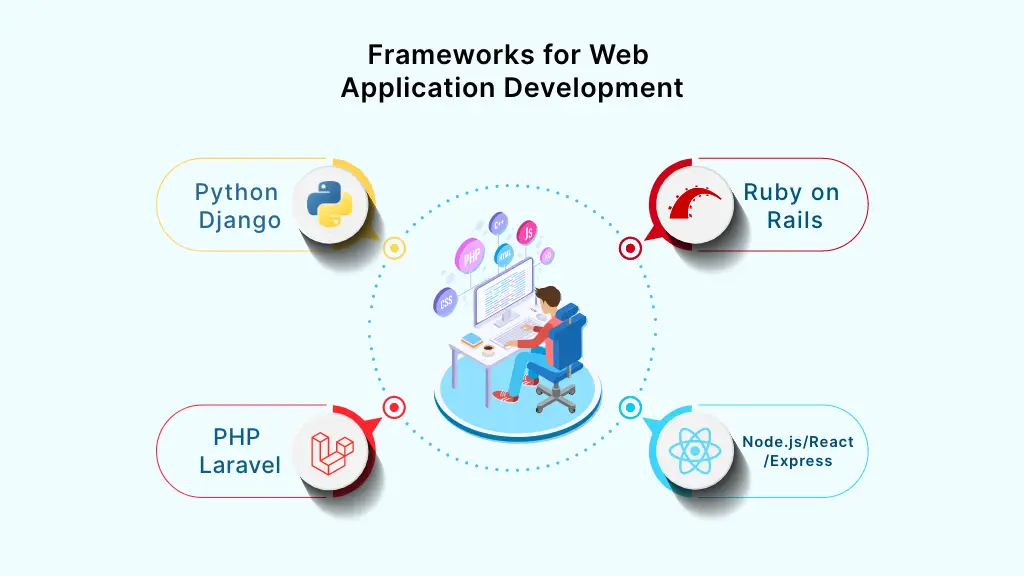
- Node.js/React/Express: Node.js is a powerful JavaScript runtime that allows server-side scripting, while React is a popular JavaScript library for building user interfaces. Together with Express.js, a minimalist web application framework, they form a powerful MVC (Model-View-Controller) framework stack. This combination enables developers to build scalable and high-performing web applications using JavaScript across the entire stack. Node.js provides server-side capabilities, React handles the front-end rendering, and Express.js facilitates routing and middleware functionalities.
- PHP Laravel: Laravel is a robust PHP framework known for its elegance and simplicity. It follows the MVC architectural pattern and offers a wide range of features to streamline web application development. Laravel provides a clean and expressive syntax, built-in authentication and authorization mechanisms, database management tools, caching, and routing capabilities. It also has a vibrant community, extensive documentation, and a rich ecosystem of packages, making it a popular choice for PHP web application development.
- Python Django: Django is a high-level Python web framework that prioritizes simplicity and speed. It follows the MVC pattern and offers a comprehensive set of tools and functionalities for building web applications. Django provides an ORM (Object-Relational Mapping) layer for database management, built-in authentication, URL routing, template engine, and robust security features. Its “batteries included” philosophy allows developers to quickly build feature-rich web applications while adhering to best practices and security standards.
- Ruby on Rails: Ruby on Rails, often referred to as Rails, is a full-stack web application framework written in Ruby. Rails follows the MVC architecture and emphasizes convention over configuration, enabling developers to focus on application logic rather than repetitive setup tasks. Rails provides a wide range of features, including database management with Active Record, automatic scaffolding, routing, and session management. It promotes code simplicity and readability, making it a popular choice for rapid web application development.
- Choosing the Right Framework for Your Project: Each of these frameworks has its own strengths and considerations, and the choice depends on factors such as project requirements, team expertise, and scalability needs. Researching and understanding each framework’s specific features, community support, and learning resources can help you make an informed decision.When selecting a framework, consider factors such as development speed, scalability, ease of maintenance, community support, and available libraries or extensions. Additionally, evaluate the framework’s compatibility with your chosen programming language and its ability to integrate with other tools and technologies that are crucial for your project.It’s important to note that these frameworks constantly evolve, with new versions and updates being released regularly. Staying up to date with the latest releases and community trends can help you leverage the full potential of the chosen framework and ensure that your web application remains secure and performant.
In the next topic, we will delve into the concept of low-code development and how it can optimize the web application development process. We will explore its benefits, considerations, and best practices for utilizing low-code platforms effectively.
Low-Code Development for Web Applications

In recent years, low-code development has gained significant popularity as a powerful approach to expedite the process of building web applications. In this topic, we will explore the concept of low-code development, its benefits, and examine two popular low-code frameworks: Bubble and Power Apps. This may not be suitable for building applications at scale such as building a SaaS application or marketplaces so all requirements and road-map considerations need to be considered when choosing low-code as a choice.
[ Also Read: 10 Best Low-Code Platforms You Must Try in 2023 ]
Understanding Low-Code Development: Low-code development refers to a visual development approach that enables users to create applications with minimal hand-coding and a focus on visual modeling. It allows developers and non-technical users to collaborate effectively, streamlining the development process and reducing the time and effort required to build web applications. Low-code platforms provide a range of pre-built components, drag-and-drop interfaces, and visual workflows, enabling rapid application development.
- Bubble: Bubble.io is a popular low-code development platform for building web applications without writing code. With its visual editor, Bubble enables users to design and develop web applications by visually defining data structures, workflows, and user interfaces. It offers a wide range of built-in features, such as database management, user authentication, third-party integrations, and responsive design. Bubble empowers both technical and non-technical users to create complex web applications efficiently.
- Power Apps: Power Apps is a low-code development platform provided by Microsoft. It allows users to build web applications, mobile apps, and forms using a visual interface and minimal coding. Power Apps integrates seamlessly with other Microsoft products, such as Microsoft 365 and Azure, offering extensive connectivity and data integration capabilities. With Power Apps, users can leverage pre-built templates, drag-and-drop components, and powerful data binding to create functional and professional web applications.
Benefits of Low-Code Development: Low-code development offers several advantages for web application development:
a) Accelerated Development: Low-code platforms provide pre-built components, templates, and visual interfaces that speed up development. This allows businesses to quickly bring their web applications to market, gaining a competitive edge.
b) Collaboration and Agility: Low-code platforms facilitate collaboration between developers, designers, and business stakeholders. The visual nature of low-code development promotes efficient communication and iterative development, enabling agility and flexibility in responding to changing requirements.
c) Reduced Technical Complexity: Low-code platforms abstract away much of the technical complexity, allowing non-technical users to actively participate in the development process. This empowers business users to contribute to the creation of web applications, reducing the dependency on IT teams.
d) Faster Iteration and Continuous Improvement: Low-code platforms enable rapid prototyping and iterative development. Developers can quickly gather user feedback, make changes, and continuously improve the application without cumbersome code modifications.
Considerations for Low-Code Development
While low-code development offers significant benefits, it is important to consider the following:
a) Customization Limitations: Low-code platforms prioritize simplicity and ease of use, which may result in some limitations regarding customization and fine-grained control over certain functionalities.
b) Platform Lock-in: When adopting a specific low-code platform, consider the long-term implications and ensure that the platform aligns with your scalability, integration, and future expansion needs.
c) Learning Curve: Although low-code platforms aim to make development accessible to non-technical users, there is still a learning curve involved. Familiarizing yourself with the platform’s features and capabilities is crucial for leveraging its full potential.
By embracing low-code development and utilizing platforms like Bubble and Power Apps, businesses can expedite the process of building web applications, foster collaboration, and drive innovation. These platforms enable a broader range of users to actively participate in the development process, leading to increased productivity and accelerated time-to-market.
In the next topic, we will guide you through the steps to transform your web application idea into a fully functional, launched product. We will explore the crucial steps involved, from idea to launch.
From Idea to Launch: Transforming Your Web Application
In this topic, we will guide you through the essential steps to transform your web application idea into a fully functional and launched product. We will explore the crucial stages involved in the development process, emphasizing the importance of lean principles and agility.

- Ideation and Planning: The first step is solidifying your web application idea and outlining your goals and objectives. Conduct market research to identify potential users, assess competition, and validate your concept. Once you have a clear vision, create a roadmap and develop a plan that outlines the necessary features, timelines, and resources required for your web application.
- Minimum Viable Product (MVP) Development: Adopting lean principles, focus on developing an MVP – a stripped-down version of your web application that includes the core features and functionality. The goal is to build a working prototype to launch and test with real users. This approach allows you to gather valuable feedback, validate assumptions, and make informed decisions about the direction of your product.
- Agile Development and Iteration: To drive the development process, utilize agile methodologies, such as Scrum or Kanban. Break down the development tasks into smaller, manageable increments and work on them in short iterations or sprints. Regularly review and prioritize features, adapt to user feedback, and iterate on the product to improve its functionality and user experience. Agile development promotes flexibility, adaptability, and continuous improvement.
- Continuous Integration and Deployment: Implement continuous integration and deployment (CI/CD) practices to streamline the development and release process. Automate testing, code reviews, and the deployment pipeline to ensure that changes are quickly integrated, tested, and deployed to production. CI/CD practices enable faster iterations, reduce the risk of errors, and enhance the overall development workflow.
- User Testing and Feedback: Involve users throughout the development process by conducting user testing and gathering feedback. Incorporate user feedback into your iterations to refine and enhance your web application. Regularly seek insights from your target audience to ensure your product aligns with their needs, preferences, and pain points. User-centric development is crucial for creating a successful web application.
- Performance Optimization and Scalability: Pay attention to performance optimization and scalability as your web application evolves. Optimize code, minimize loading times, and ensure your application can handle increased traffic and user demands. Monitor and analyze key performance metrics to identify bottlenecks and optimize the user experience. Scalability is vital to accommodate growth and handle increased user load effectively.
- Security and Compliance: Maintain a strong focus on security and compliance throughout the development process. Implement robust security measures, including secure authentication, data encryption, and protection against common vulnerabilities. Adhere to industry standards and regulations, such as GDPR or HIPAA, to protect user data and ensure legal compliance.
- Launch and Post-Launch Monitoring: Once your web application is ready, launch it to the public. Monitor its performance, user feedback, and analytics closely. Continuously iterate and enhance your product based on real-world usage and feedback. Monitor market trends, user needs, and technological advancements to plan future updates and feature enhancements.
One notable individual who has made significant contributions to lean principles and agility is Mary Poppendieck. Mary, along with her husband Tom Poppendieck, authored several influential books, such as “Lean Software Development: An Agile Toolkit” and “Implementing Lean Software Development: From Concept to Cash.” They have been instrumental in applying lean principles from manufacturing to the software development process, emphasizing the elimination of waste, continuous improvement, and a focus on customer value.
Conclusion:
In today’s fast-paced digital landscape, developing web applications that deliver exceptional user experiences and drive business success is essential. As a technology-driven company dedicated to bringing applications to life, Bitcot is a reliable partner for your web application development needs.
Choosing BitCot as your development partner offers several advantages that set us apart:
- Exceptional Talent Pool: BitCot boasts a team of highly skilled and experienced professionals who excel in various technologies and development frameworks. Our talented developers, designers, and engineers possess the expertise to bring your vision to reality and create innovative, high-quality web applications.
- Industry Best Practices: We follow industry-leading best practices and adhere to rigorous coding standards to ensure that your web application is robust, scalable, and secure. Our team stays updated with the latest technological advancements, enabling us to implement cutting-edge solutions and deliver superior results.
- Time to Market: At Bitcot, we understand the importance of time to market. Our agile development approach, streamlined processes, and efficient project management enable us to deliver your web application within the stipulated timelines. We prioritize rapid development without compromising quality or functionality.
- Outcome-Focused Approach: We take a results-driven approach, emphasising understanding your business objectives and end-user needs. By aligning our development efforts with your desired outcomes, we ensure that your web application delivers tangible value, drives engagement, and achieves the desired business goals.
- Collaboration and Guidance: We believe in fostering strong partnerships with our clients. We actively engage with you throughout development, asking pertinent questions and providing expert guidance at every step. We strive to understand your unique business challenges and offer innovative ideas to improve your web application.
By choosing Bitcot as your web app development partner, you gain a trusted ally committed to your success. We are not merely a service provider but a collaborative partner invested in the growth of your business. We go above and beyond to deliver exceptional web applications that make a lasting impact.
As you embark on your web application development journey, partnering with BitCot provides you with a skilled talent pool, adherence to industry best practices, a focus on time to market, an outcome-driven approach, and collaborative guidance. Together, we can create web applications that stand out, drive business growth, and elevate the user experience.
Contact BitCot today and let us bring your web application ideas to life, making a meaningful impact on your business and customers.




